NDVI stands for "Normalized Difference Vegetation Index". NRG stands for "Near-infrared / Red / Green". NDVI and NRG are both ways to visualize the amounts of infrared and other wavelengths of light reflected from vegetation. Because both these methods compare ratios of blue and red light absorbed versus green and IR light reflected, they can be used to evaluate the health of vegetation. It's a snapshot of how much photosynthesis is happening. This is helpful in assessing vegetative health or stress. (Read more here: https://www.agronomy.org/publications/jeq/articles/36/3/832) ## Do-It-Yourself These techniques for vegetation analysis were developed for satellite imagery, but at Public Lab, we've been working a lot on capturing infrared imagery using our DIY [near-infrared camera](/wiki/near-infrared-camera) setup, and combining it with visible bands to produce NDVI images such as the one above. ## What these images mean What exactly are these images we're trying to make? What do they tell us about vegetation, and why? These diagrams should help to understand what it is we're doing and why these are good ways to analyze plant life. ## The NDVI equation [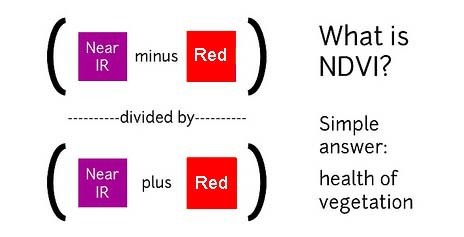](/i/44723) **NDVI = (Near Infrared - Red)/(Near Infrared + Red)** NDVI is a ratio which tries to emphasize photosynthesis while filtering out sun glare. The above equation is run for every pixel, using source data from an infrared photo and a visible light photo, like this pair: [](https://publiclab.org/system/images/photos/000/021/771/original/5390895115_c9d4d38fec_o.jpg) The result can be false-colored to make the high-photosynthesis areas more clear, and used to examine where plants are and how healthy they are. [](https://publiclab.org/system/images/photos/000/021/770/original/PetVISNDVIcomp.png) _Figure above: Normal color photo (right) and normalized difference vegetation index (NDVI) image (left). NDVI image was derived from two color channels in a single photo taken with a camera modified with a special infrared filter. Note that tree trunks, brown grass, and rocks have very low NDVI values because they are not photosynthetic. Healthy plants typically have NDVI values between 0.1 and 0.9. -- @cfastie_ ### Activities Here are a range of activities you can do to produce and interpret your own NDVI imagery, whether downloaded from a satellite imagery provider or [collected yourself using a DIY technique](/wiki/multispectral-imaging) [activities:ndvi] ****   Most DIY converted cameras today (those from Public Lab) use RGN instead of NRG, so the blue channel represents infrared instead of the red channel. That looks like this: [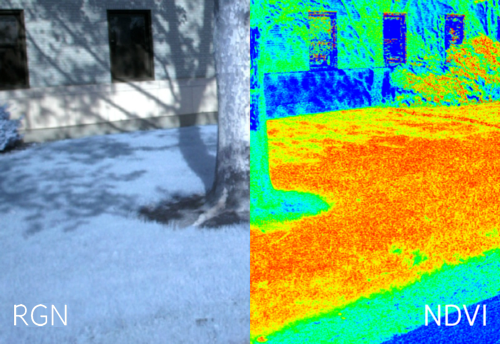](/i/45468?s=o) **** ## NRG imagery Some people are also interested in producing NRG imagery (like the below image), where `Near-Infrared, Red, and Green` are used to compose a picture instead of the usual `Red, Green, and Blue`. [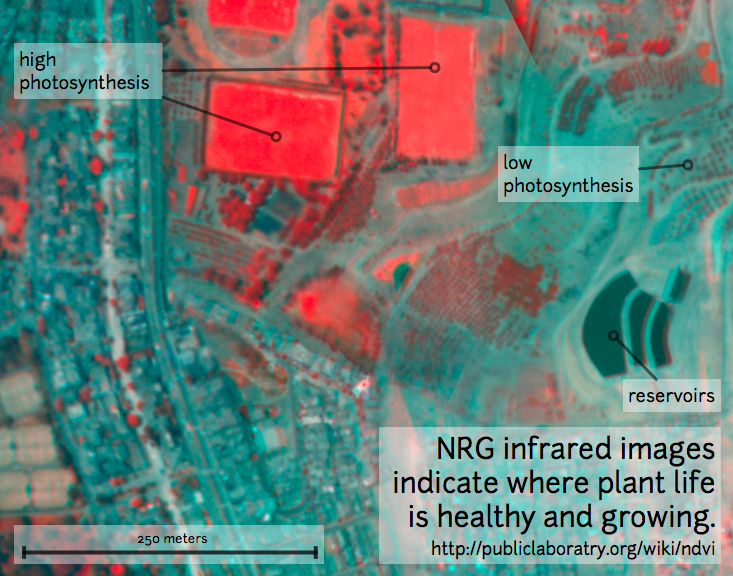](/i/25064) This diagram explains the swapping, which allows us to 'see' infrared as if it were a normal color: [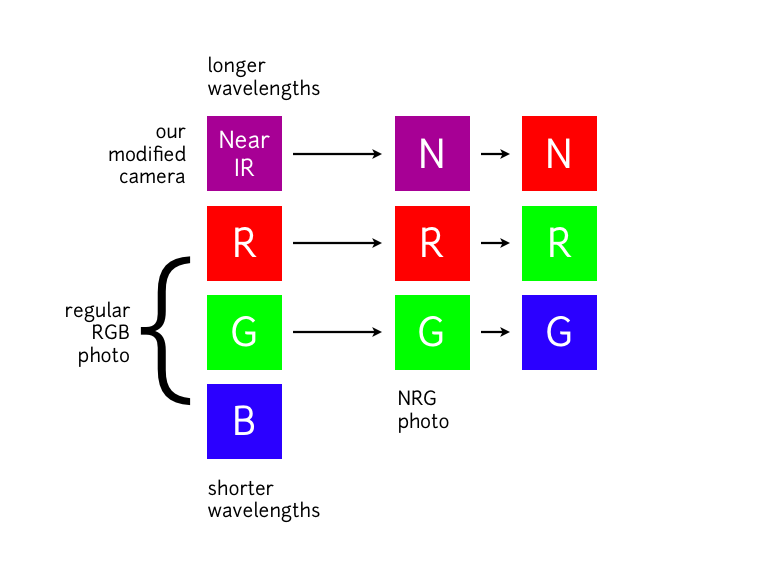](/i/25063) **In NRG images, the deeper and clearer the red color, the denser and healthier the vegetation (more or less).** ### Questions [questions:ndvi] ### Other examples of DIY NDVI imaging From around the internet: Begin watching at 2 minutes to see the resulting imagery: *This topic is part of the [Grassroots Mapping Curriculum](/wiki/mapping-curriculum) series.* **** [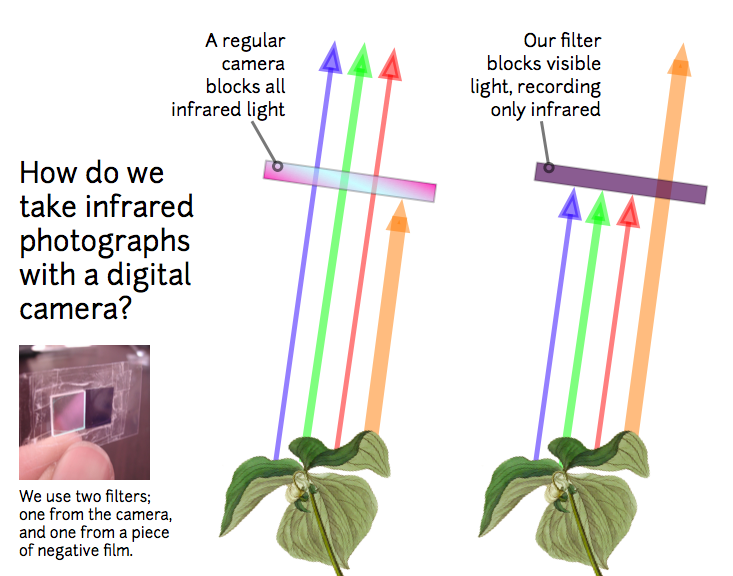](/i/25066) [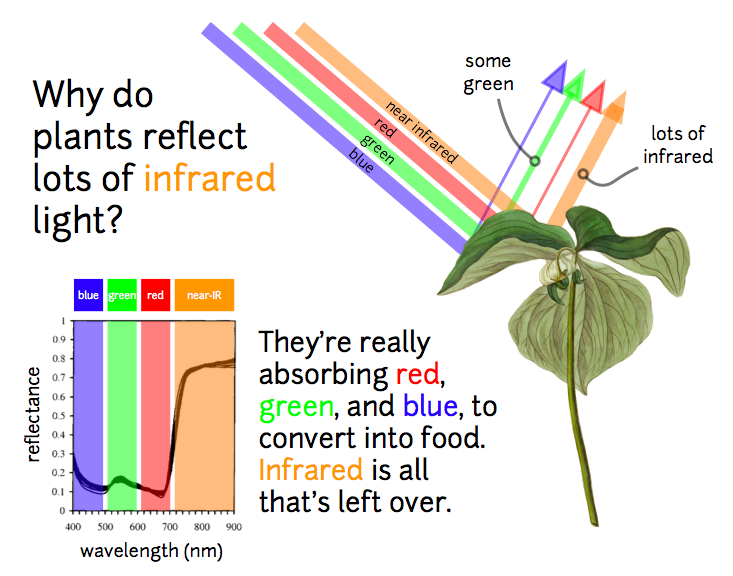](/i/25065) ...
| Author | Comment | Last activity | Moderation | ||
|---|---|---|---|---|---|
| umberto_rootman | " Another great source for infrared color photos: a Roscolux sample book of 200 filters, of which at least 50 - 80 filters are useful. https://us...." | Read more » | over 4 years ago | |||
| umberto_rootman | "Excellent! On Wed, May 20, 2020 at 5:55 PM \<notifications@publiclab.org> wrote: Hi! There's been a response to your research note 'Cheap s..." | Read more » | over 4 years ago | |||
| liz | "What would you say to the idea of changing the title of this post to "use 3-D glasses to modify a sport cam for infrared" ? " | Read more » | over 4 years ago | |||
| brendan_stanford | "The Raspberry Pi is housed in an aluminum enclosure, but the camera points out an airlock porthole on the International Space Station; I am unsure ..." | Read more » | over 4 years ago | |||
| mimiss | "May I ask what material your camera is housed in? Some materials have very high NDVI values, and it looks like this material is so high in comparis..." | Read more » | over 4 years ago | |||
| umberto_rootman | "In the glare in the wind mill pic, left above, is a small spectrum visible, which illustrates which wavelengths are blocked by the filter: there is..." | Read more » | over 4 years ago | |||
| liz | "Thank you! Great pic of the glasses cut up! " | Read more » | over 4 years ago | |||
| umberto_rootman | "As stated, the cyan filter was cut out from 3-D glasses " | Read more » | over 4 years ago | |||
| sam14 | "Great, thanks Liz! " | Read more » | over 4 years ago | |||
| liz | "Thanks for sharing this! Very cool. I don't think i've seen anyone discussing a cyan filter before, can you share a link to what you're using? " | Read more » | over 4 years ago | |||
| umberto_rootman | "The great thing about using the cyan or blue filter with a modded sports cam is the ability to record images or video without having to resort to c..." | Read more » | over 4 years ago | |||
| umberto_rootman | "I often use an orange-red filter, handheld in from of the camera, from a scrapped enlarger. I do a white balance with the eye dropper tool in PS, G..." | Read more » | over 4 years ago | |||
| liz | "Hi @Sam14, Image Sequencer has experimental support for processing gifs: https://github.com/publiclab/image-sequencer#experimental-gif-processing-s..." | Read more » | over 4 years ago | |||
| warren | "Hi! It could be interesting to try measuring the berries themselves as well; check out the spectrometer work by this group for a reference! #webval..." | Read more » | over 4 years ago | |||
| cfastie | "If photos are taken of plants in two treatments (top and bottom) with the same camera settings (all manual control) under the exact same lighting c..." | Read more » | almost 5 years ago | |||
| M0nk3y | "Hi there, i did'nt wanted to re-do a topic that would have been really similar as this one. I hope i will be enough precise to get an answer to my ..." | Read more » | almost 5 years ago | |||
| warren | "Yes of course!!! " | Read more » | almost 5 years ago | |||
| yaina | "This is this illuminating article for all of us. Extremely incredibly seriously incomprehensible content parts. We essentially gain searching state..." | Read more » | almost 5 years ago | |||
| lev29 | "Thank you, Chris! You've given me much to read and think about, but please, don't misconstrue that as meaning you shouldn't add any additional pert..." | Read more » | almost 5 years ago | |||
| cfastie | "Using green foliage (or chlorophyll) to set a custom white balance deserves more consideration than I gave it in my last comment. Foliage absorbs r..." | Read more » | almost 5 years ago | |||
| cfastie | "The goal of the custom white balance hack is to fool the camera into wildly exaggerating the brightness of the blue channel (when using a red filte..." | Read more » | almost 5 years ago | |||
| lev29 | "Thank you so much, Chris! With respect to what to use as a reference to calibrate the White Balance (WB), I have not yet "digested" whether your re..." | Read more » | almost 5 years ago | |||
| cfastie | "If your K610 filter is a cutoff filter that passes wavelengths greater than 610nm and blocks shorter wavelengths, then it is similar to many filter..." | Read more » | almost 5 years ago | |||
| lev29 | "Thank you, Chris, for helping to clarify my question. In fact, as you suspected, I was misusing the term "bandpass"! Those I signify with a "K" fol..." | Read more » | almost 5 years ago |